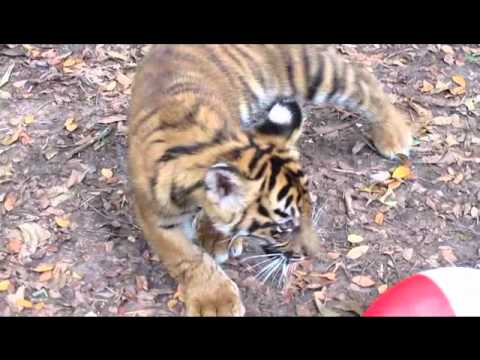- The biology and behavior of Sumatran tiger cubs: an exploration of their early life, development, and adaptation to their habitat.
- The importance of zoo management practices in ensuring the health and safety of Sumatran tiger cubs, with a focus on nutrition, medical care, and environmental enrichment.
- The role of wildlife conservation efforts in preserving Sumatran tigers, highlighting the challenges faced in their natural habitat and the strategies used to protect this critically endangered species.
- Insights from Up Close with a Sumatran Tiger Cub video, providing viewers with a deeper understanding of the day-to-day interactions and care involved in nurturing these young animals.
- The significance of educational outreach and community engagement in raising awareness about Sumatran tiger conservation and fostering a global commitment to protecting biodiversity.
Sumatran tigers, the smallest of all tiger subspecies, are native to the Indonesian island of Sumatra. These magnificent cats are critically endangered, with only a few hundred individuals remaining in the wild. Understanding the biology and behavior of Sumatran tiger cubs is essential in both zoo settings and for efforts to conserve them in their natural habitat. Born after a gestation period of about 103 days, Sumatran tiger cubs enter the world blind and utterly dependent on their mothers for survival. During the first few weeks, cubs are hidden away in dense vegetation where they nurse and grow rapidly, developing the motor skills necessary to explore their surroundings.
These early stages are crucial for their development. Young tigers learn vital social behaviors and establish play patterns that resemble the hunting techniques they will need later in life. Play, in particular, serves as a form of exercise and a way to hone skills such as stalking and pouncing. Experts in zoos simulate these activities through interactive enrichment strategies that mimic natural settings. This includes providing a variety of sensory stimuli and physical challenges to encourage growth and development, both physically and cognitively.
Zoo management plays a critical role in ensuring the health and success of Sumatran tiger cubs. It involves a comprehensive approach that includes diet formulation, medical care, and habitat enrichment. Nutrition is carefully managed to mirror the diet tigers would consume in the wild, consisting largely of fresh meat supplemented with essential nutrients. Veterinary teams frequently assess the health of the cubs, conducting regular physical examinations and vaccinations to guard against disease.
Another integral component of zoo management is environmental enrichment. This involves designing enclosures that replicate a natural environment as closely as possible, with opportunities for climbing, hiding, and observing the world around them. These habitats are crucial for maintaining the physical and psychological health of the cubs, providing them with the autonomy to interact within a safe and controlled environment. Behavioral observations allow zookeepers to adjust their strategies, supporting cubs in developing skills they would traditionally learn from their mothers.
Wildlife conservation is at the forefront of efforts to preserve Sumatran tigers, both in the wild and in captivity. Poaching, habitat destruction, and human-wildlife conflict are significant threats to their survival. Without active intervention, the risk of extinction is imminent. Conservation strategies include anti-poaching patrols, habitat restoration projects, and community education programs aimed at mitigating conflicts between humans and tigers in their native regions.
One of the key strategies in conserving Sumatran tigers involves maintaining genetically viable populations both in the wild and in captive breeding programs. This requires genetic monitoring and coordinated breeding efforts among zoos worldwide to ensure a diverse gene pool. Partnerships between conservation organizations, governments, and local communities play a vital role in these initiatives, providing the resources and support necessary to carry out extensive conservation work.
The Up Close with a Sumatran Tiger Cub video provides an intimate glimpse into the daily lives and care of these young animals. Viewers learn about the rigorous processes zoo staff maintain in nurturing these cubs, from feeding and interaction to monitoring growth and development. This video serves as an exceptional educational tool, showcasing the dedication and expertise involved in caring for such a critical species.
Insightful and well-produced, the video emphasizes the intricate care involved in zoo settings, encouraging viewers to reflect on the broader implications of conservation and the interconnectedness of global biodiversity. Through these narratives, the audience gains a comprehensive understanding of the challenges facing Sumatran tigers and the ongoing efforts required to safeguard their future.
Educational outreach and community engagement are paramount in global conservation efforts, aimed at fostering a widespread commitment to protecting Sumatran tigers. Zoo programs develop initiatives that involve the public, such as interactive workshops, lectures, and behind-the-scenes tours, to convey the importance of wildlife conservation. These activities inspire proactivity and advocacy among participants, encouraging a global synergy in conservation efforts.
Furthermore, digital platforms amplify the reach of conservation messages, with video content like Up Close with a Sumatran Tiger Cub engaging a broader audience. By merging entertainment with education, these platforms enhance understanding and generate interest and support for conservation endeavors. Through continuous outreach and education, a greater appreciation for the critical situation of Sumatran tigers can be cultivated, inspiring action to protect them.
Ultimately, ensuring the survival of Sumatran tigers requires a multifaceted approach. This involves detailed understanding of their biology and behavior, robust management and care practices in zoos, and concerted conservation efforts worldwide. Engaging public interest and involvement through educational content remains crucial to conserving these remarkable animals for future generations.
*****
Source Description
The cubs are much bigger than this now. When they were smaller, keepers went in the exhibit to make sure the cubs stayed safe. They got some up close and personal shots of the cubs.


